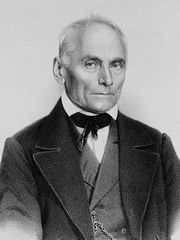This article is part of the series "A Moment in History" where we honor those who have contributed to the growth of medical knowledge in the areas of anatomy, medicine, surgery, and medical research.To search all the articles in this series, click here. |
|
|
Jan Evangelista Purkinje (1787 - 1869). Known by his German name Purkinje, or his Czech name, Purkyn?, as well as his church-given name Salverius. Purkinje was born in the city of Libochovice, Bohemia, (now Czechoslovakia). He started his early studies in the church with Piarist monks. He took the name of Brother Salverius and served as a teacher in the Piarist schools. He dedicated himself to the study of natural sciences. Purkinje left the monastery before taking his final vows. Purkinje continued his studies and graduated in medicine in Prague. Even as a student Purkinje started research on the physics of sound and the physiology of vision, which he continued after his graduation. Purkinje was one of the first to understand the vision of motion, thus creating the first animated cartoons! In 1823 Purkinje was appointed Professor of Physiology at the University of Wroclaw (Breslau), later taking the same chair in Prague. Besides being one of the first to propose experimental physiology as basis for research, Purkinje was one of the first to use the microscope to study the cells of the body, proposing the "cell theory", and introducing the word "protoplasm". |
 Original imagecourtesy of Wikipedia. Original imagecourtesy of Wikipedia. |
| He made a number of discoveries, and his name is eponymically tied to many structures and processes, such as:
• Purkinje's cell of the cerebellum: Piriform cells found in Purkinje's layer Sources: |
|
| Back to MTD Main Page | Subscribe to MTD |